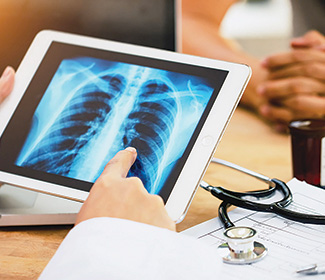 If you’ve never smoked a cigarette, you might assume you’re safe from developing lung cancer. But, according to recent statistics, you’d be wrong.
If you’ve never smoked a cigarette, you might assume you’re safe from developing lung cancer. But, according to recent statistics, you’d be wrong.
While smoking is the number one risk factor for lung cancer, recent research shows the rates of lung cancer in people who have never smoked are steadily climbing.
A study published in January 2017 in the Journal of the National Cancer Institute found an estimated 10 to 15 percent of lung cancer occurs in never-smokers, and that the incidence of non-small-cell lung cancer (the most common type) in never-smokers is on the rise, increasing by eight percent between 1990 and 1995 and by 14 percent between 2011 and 2013.
In fact, as many as 20 percent of people who die from lung cancer each year have never smoked or used any form of tobacco, according to the American Cancer Society.
Women never-smokers are more susceptible than men, according to the statistics: Women who have never smoked have twice the risk of developing lung cancer as men. In fact, a study published in September 2020 in Lung Cancer Management showed that nearly half of women diagnosed with lung cancer worldwide are never-smokers, compared with only about 15 to 20 percent of men.
WHAT’S BEHIND THE SURGE?
The explanation is complex, likely due to many factors, and not fully understood, says Andrew Kaufman, MD, a thoracic surgeon at Mount Sinai Hospital in New York City. “We know very little about why this is occurring, and why it seems to be occurring at higher rates now compared with historical time points,” he says.
There are most likely many causes that contribute to the increase in lung cancer cases among never-smokers. Here are some possible reasons:
- Simple Math: “The number of people who never smoked as a proportion of the general population is higher now than ever in the last 100 years because the rates of smoking have declined to about 20 percent of the adult population,” says Dr. Kaufman. “So, with fewer people having a history of smoking, there is a higher chance for diagnosing lung cancer that is not attributable to smoking.”
- Genetic Mutations: People who have never smoked are more likely to have genetic mutations — changes in the DNA that makes up a gene — that contribute to cancer development. The good news is there are drugs and therapies available to target a lot of these mutations.
- Family History: People with a family history of lung cancer have a greater risk of developing cancer themselves. This is especially true if you have a first-degree relative (a parent, sibling, or child) who developed lung cancer before age 50.
- Radon Exposure: Radon is a naturally occurring radioactive gas that trickles into homes from the ground. Researchers at Yale Medicine estimated radon gas exposure accounts for about 21,000 lung cancer deaths each year. Exposure to radon is the second leading cause of lung cancer. The Environmental Protection Agency (EPA) estimates that one out of every 15 homes in the United States has unsafe levels of radon.
- Secondhand Smoke: Smoke breathed in from another person’s cigarette or tobacco product, accounts for about 7,000 lung cancer deaths each year in the United States, per Yale Medicine. Researchers are also looking at the impact of “third-hand smoke.” This is the film of nicotine and chemicals that may be left on walls, furniture, clothing and other surfaces.
- Other Environmental Pollutants: Other environmental factors, such as exposure to air pollution, diesel exhaust, asbestos, and arsenic may lead to lung cancer in people who don’t smoke.
Never-smokers can help lower their risk of lung cancer by avoiding secondhand smoke and exposure to radon or other harmful pollutants. It’s also important to seek medical care if you develop any early symptoms, because lung cancer, especially, is a disease that is most easily treated when caught early.
Signs and symptoms of lung cancer
Like most cancers, symptoms of lung cancer don’t tend to present themselves until later stages. Symptoms of advanced-stage lung cancer can include:
- Tiredness or fatigue.
- Persistent cough.
- Trouble breathing and shortness of breath.
- Discomfort in the chest and surrounding areas.
- Coughing up mucus or phlegm.
- Coughing up blood (hemoptysis)
If you’re experiencing any of the above symptoms, call your doctor and schedule a lung cancer screening. From there your doctor will decide which diagnostic test you may qualify for.
As with any cancer, the earlier you can find lung cancer, the better. Preventative lung cancer screenings for high-risk patients is a key component of early detection and intervention.
(Information from SSMHealth at ssmhealth.com/cancer/lung-cancer.)


